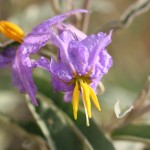Silverleaf nightshade
Solanum elaeagnifolium Cav.
Solanaceae (Nightshade family)
Description
Silverleaf nightshade is an upright, usually prickly perennial in the Potato or Nightshade family. It normally grows 1 to 3 feet tall. This plant reproduces by seed and creeping root stalks.
Its characteristic silver color is imparted by the tiny, starlike, densely matted hairs covering the entire plant. The leaves have wavy margins and are lance shaped to narrowly oblong. The showy violet or bluish (sometimes white) flowers are followed by round, yellow fruits of up to › inch in diameter from May to October.
The plant has poor forage value for livestock and wildlife and can be poisonous to livestock.
Habitat
Silverleaf nightshade is a serious weed of prairies, open woods and disturbed soils in southwestern United States and Mexico. It is occasionally found even farther north than Missouri.
Toxic Agent
This plant has reportedly poisoned horses, sheep, goats, cattle and humans. However, sheep and goats are more resistant than cattle, and in controlled experiments, goats were not poisoned at all. Its toxic agent is solanine. The leaves and fruit are toxic at all stages of maturity; the highest concentration is in ripe fruits. In some instances, an animal can be poisoned by eating 0.1 to 0.3 percent of its weight in silverleaf nightshade.
Signs of Livestock Ingestion
The glycoalkaloid can cause two types of effects. Nervous effects include: Incoordination; Excessive salivation; Loud, labored breathing; Trembling; Progressive weakness or paralysis; Nasal discharge.
Effects of gastrointestinal irritation include: Nausea; Abdominal pain; Vomiting; Diarrhea, sometimes with blood.
Postmortem examinations in some cases have revealed yellowish discoloration of the body fat. Plant material may be identified in rumen content of dead animals. In cases of fruit poisoning, many small, tomatolike seeds may be found between the folds of the omasum and in the abomasum.
Management Strategies
Veterinarians have had some success administering pilocarpine or physostigmine after the animals were removed from infested pastures. Move affected animals as little as possible and give them goodquality hay and water. Because silverleaf nightshade is relatively unpalatable, problems usually occur after serious overgrazing or if nightshade is baled up with hay. Do not feed livestock from the ground where many ripe nightshade fruits are available. If infestations become severe, apply Grazon P+D® at 0.6 to 0.9 pound a.i./acre as an aerial or ground broadcast treatment in the spring when plants begin to flower. For individual plant treatments, mix Grazon P+D® as a 1 percent solution in water. Mechanical control practices that disturb the soil surface may make the plant infestations more severe.
Images
Plant Characteristics
Flower Color: Purple
Seed Type: Fruit/Berry
Duration: Perennial
Stem Texture: Prickly, Spiny, or Thorny
Growth Habit: Forbs/Broadleaf
Leaf Shape
 : Simple with Pinnate or Parallel Venation
: Simple with Pinnate or Parallel Venation
Season: Warm
Distribution
 : 01 - Pineywoods, 02 - Gulf Prairies and Marshes, 03 - Post Oak Savannah, 04 - Blackland Prairies, 05 - Cross Timbers and Prairies, 06 - South Texas Plains, 07 - Edwards Plateau, 08 - Rolling Plains, 09 - High Plains, 10 - Trans-Pecos
: 01 - Pineywoods, 02 - Gulf Prairies and Marshes, 03 - Post Oak Savannah, 04 - Blackland Prairies, 05 - Cross Timbers and Prairies, 06 - South Texas Plains, 07 - Edwards Plateau, 08 - Rolling Plains, 09 - High Plains, 10 - Trans-Pecos
Distributions
Distribution refers to the ecological region in Texas that a plant has been found. You can also view a clickable map.
Book: Brush and Weeds of Texas Rangelands (B-6208), Toxic Plants of Texas (B-6105)
Collection: Brush and Weeds, Toxics, Wild Flowers
Livestock Affected: Cattle, Goats, Horses, Sheep
Livestock Signs: Abdominal Pain, Colic, Collapse, Coma, Depression/ Weakness, Diarrhea, Excess Salivation, Irregular Breathing, Nitrate Poisoning, Unable To Rise, Vomiting/Regurgitation





